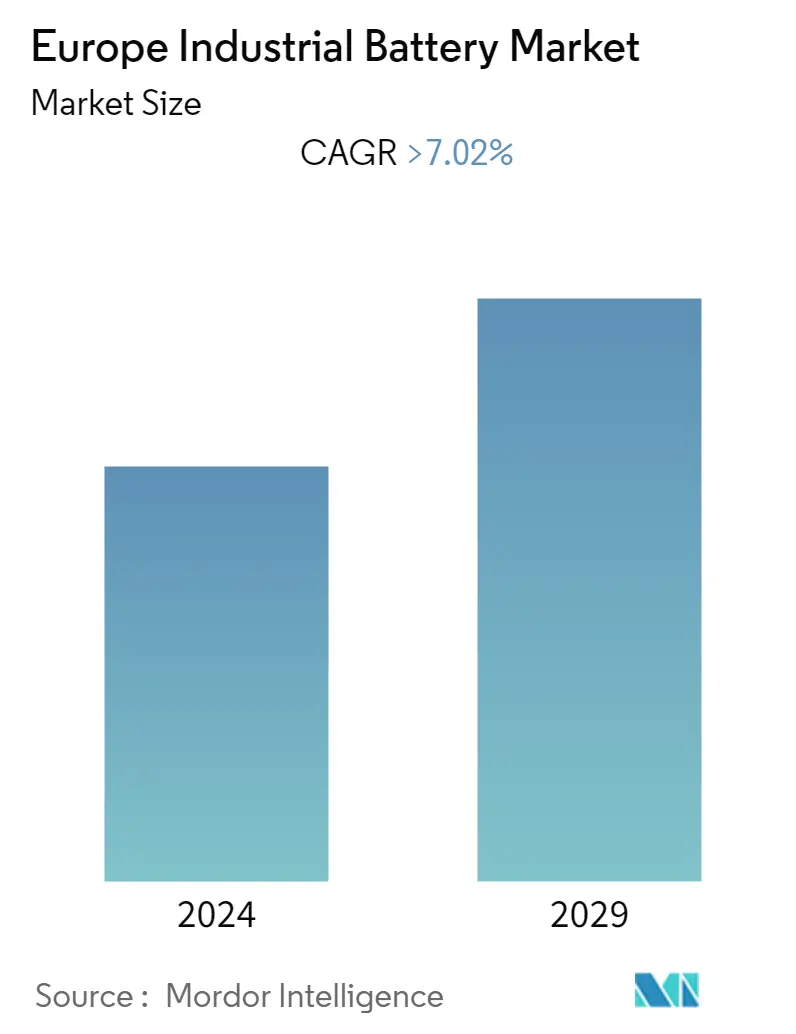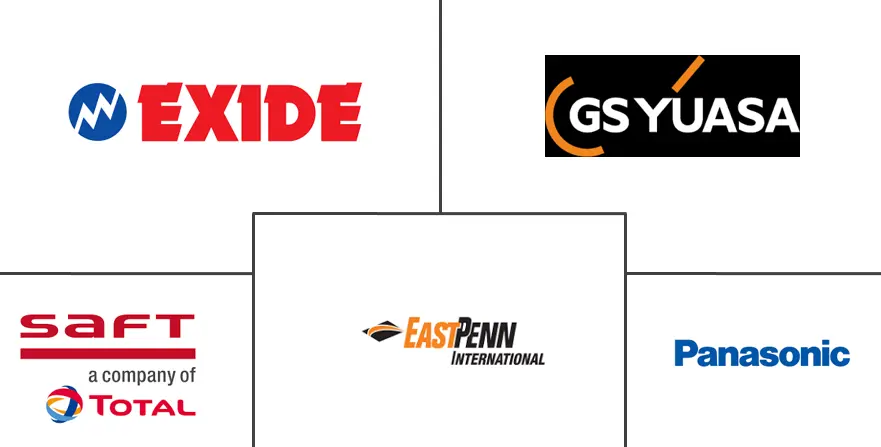Market Size of Europe Industrial Battery Industry

| Study Period | 2020 - 2029 |
| Base Year For Estimation | 2023 |
| Forecast Data Period | 2024 - 2029 |
| Historical Data Period | 2020 - 2022 |
| CAGR | > 7.02 % |
Major Players
*Disclaimer: Major Players sorted in no particular order |
Europe Industrial Battery Market Analysis
The Europe Industrial Battery Market is expected to grow at a CAGR of over 7.02% during the forecast period.
COVID-19 moderately impacted the market in 2020. Presently the market has now reached pre-pandemic levels.
- Declining lithium-ion battery prices, increasing demand from data centers and telecom sectors, along with rising renewable energy integration are some of the major factors driving the market.
- However, factors such as uncertainty in raw material prices and availability of raw materials, such as cobalt, lead, and lithium, are likely to curtail the market growth rate during the forecast period.
- The rising focus on technologically advanced batteries and the use of artificial intelligence in the R&D phase of battery manufacturing is likely to create a massive opportunity for the battery companies to invest and redirect their resources to make a breakthrough battery technology.
- Germany is expected to be the largest market during the forecast period, owing to the modest growth in the country's manufacturing/industrial sector, which requires industrial batteries for its smooth functioning.
Europe Industrial Battery Industry Segmentation
A battery can be defined as an electrochemical device (consisting of one or more electrochemical cells) that can be charged with an electric current and discharged whenever required. Batteries are usually devices made up of multiple electrochemical cells connected to external inputs and outputs.
The Europe Industrial Battery Market is segmented by technology, application, and geography. By technology, the market is segmented into lithium-ion batteries, lead-acid batteries, and other technologies. By application, the market is segmented into forklift, telecom, UPS, and others. The report also covers the market size and forecasts for the Europe industrial battery market across major countries in the region. The market size and forecasts for each segment have been done based on revenue (USD billion).
| Technology | |
| Lithium-ion Battery | |
| Lead-acid Battery | |
| Other Technologies (Nickel Cadmium Battery, Nickel Metal Hydride, Zinc Carbon, etc.) |
| Application | |
| Forklift | |
| Telecom | |
| UPS | |
| Others |
| Geography | |
| United Kingdom | |
| Germany | |
| France | |
| Rest of Europe |
Europe Industrial Battery Market Size Summary
The Europe Industrial Battery Market is poised for significant growth, driven by factors such as declining lithium-ion battery prices, increasing demand from data centers and telecom sectors, and the rising integration of renewable energy sources. The market has rebounded to pre-pandemic levels after a moderate impact from COVID-19. However, challenges such as uncertainty in raw material prices and availability, particularly for cobalt, lead, and lithium, may hinder growth. The focus on technologically advanced batteries and the incorporation of artificial intelligence in research and development present substantial opportunities for innovation and investment in breakthrough battery technologies. Germany is anticipated to be the largest market, supported by its robust manufacturing sector, which relies heavily on industrial batteries.
Lithium-ion batteries are expected to dominate the industrial battery market due to their favorable capacity-to-weight ratio, better performance, and decreasing costs. The demand for these batteries is further bolstered by their application in energy storage systems and material handling industries, where they offer advantages like fast charging and improved productivity. The manufacturing sector in Germany, a key player in the European Union, is expected to drive demand for industrial batteries, supported by advancements in telecommunications and high levels of digitization. The market is moderately fragmented, with major players like Exide Industries, GS Yuasa Corporation, and Panasonic Corporation actively participating. Recent investments, such as Vianode's sustainable battery materials plant in Norway and Northvolt's mega-factory in Sweden, highlight the ongoing efforts to establish a comprehensive battery value chain in Europe.
Europe Industrial Battery Market Size - Table of Contents
-
1. MARKET OVERVIEW
-
1.1 Introduction
-
1.2 Market Size and Demand Forecast in USD billion, till 2028
-
1.3 Battery Price Trends and Forecast in USD per kWh, by Major Technology Type
-
1.4 Recent Trends and Developments
-
1.5 Government Policies and Regulations
-
1.6 Market Dynamics
-
1.6.1 Drivers
-
1.6.2 Restraints
-
-
1.7 Supply Chain Analysis
-
1.8 Porter's Five Forces Analysis
-
1.8.1 Bargaining Power of Suppliers
-
1.8.2 Bargaining Power of Consumers
-
1.8.3 Threat of New Entrants
-
1.8.4 Threat of Substitutes Products and Services
-
1.8.5 Intensity of Competitive Rivalry
-
-
-
2. MARKET SEGMENTATION
-
2.1 Technology
-
2.1.1 Lithium-ion Battery
-
2.1.2 Lead-acid Battery
-
2.1.3 Other Technologies (Nickel Cadmium Battery, Nickel Metal Hydride, Zinc Carbon, etc.)
-
-
2.2 Application
-
2.2.1 Forklift
-
2.2.2 Telecom
-
2.2.3 UPS
-
2.2.4 Others
-
-
2.3 Geography
-
2.3.1 United Kingdom
-
2.3.2 Germany
-
2.3.3 France
-
2.3.4 Rest of Europe
-
-
Europe Industrial Battery Market Size FAQs
What is the current Europe Industrial Battery Market size?
The Europe Industrial Battery Market is projected to register a CAGR of greater than 7.02% during the forecast period (2024-2029)
Who are the key players in Europe Industrial Battery Market?
Exide Industries Ltd, GS Yuasa Corporation, East Penn Manufacturing Company Inc. , Panasonic Corporation and Saft Groupe SA are the major companies operating in the Europe Industrial Battery Market.

